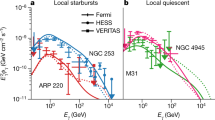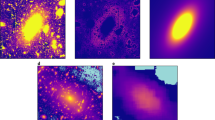Abstract
The origin of the cosmic X-ray background radiation1,2 has remained mysterious since its discovery3 thirty-five years ago. Investigation of its origin has been difficult because instruments have had insufficient resolution to distinguish small, faint sources in the hard X-ray band (above 2 keV) that dominates the background. Until now, only three per cent of the flux in the 2–10 keV band could be attributed to individual sources4,5. Here we report the results of a survey 100 times more sensitive than previous studies in the 2–10 keV band. We find many faint resolved sources, whose integrated flux accounts for 30 per cent of the X-ray background in this energy range. The average spectrum of the resolved sources is harder than those of nearby bright active galactic nuclei and is close to the spectrum of the X-ray background radiation. This means that a new class of sources, with hard X-ray spectra, dominate the sky at photon energies above 2 keV.
This is a preview of subscription content, access via your institution
Access options
Subscribe to this journal
Receive 51 print issues and online access
$199.00 per year
only $3.90 per issue
Buy this article
- Purchase on Springer Link
- Instant access to full article PDF
Prices may be subject to local taxes which are calculated during checkout



Similar content being viewed by others
References
Fabian, A. C. & Barcons, X. The origin of the X-ray background. Annu. Rev. Astron. Astrophys. 30, 429–456 (1992).
Hasinger, G. The extragalactic X-ray and gamma-ray background. Astron. Astrophys. Suppl. Ser. 120, 607–614 (1996).
Giacconi, R., Grusky, H., Paolini, F. R. & Rossi, B. B. Evidence for X-rays from sources outside the Solar system. Phys. Rev. Lett. 9, 439–443 (1962).
Piccnotti, G. et al. Acomplex X-ray sample of the high-latitude (|b| > 20°) sky from HEAO 1 A-2: Log N − Log S and luminosity functions. Astrophys. J. 253, 485–503 (1982).
Kondo, H. et al. in Proc. Frontiers of X-ray Astronomy (eds Tanaka, Y. & Koyama, K.) 655–656 (Universal Academy, Tokyo, 1991).
Marshall, F. et al. The diffuse X-ray background spectrum from 3 to 50 keV. Astrophys. J. 235, 4–10 (1980).
Mather, J. C. et al. Measurement of the cosmic microwave background spectrum by the COBE FIRAS instrument. Astrophys. J. 420, 439–444 (1994).
Shanks, T. et al. The origin of the cosmic X-ray background. Nature 353, 315–320 (1991).
Turner, T. J. & Pounds, K. A. The EXOSAT spectral survey of AGN. Mon. Not. R. Astron. Soc. 240, 833–880 (1989).
Williams, O. R. et al. The X-ray spectra of high-luminosity active galactic nuclei observed by Ginga. Astrophys. J. 389, 157–178 (1992).
Gendreau, K. C. et al. ASCA observations of the spectrum of the X-ray background. Publ. Astron Soc. Jpn 47, L5–L10 (1995).
Tanaka, Y., Inoue, H. & Holt, S. S. The X-ray astronomy satellite ASCA. Publ. Astron. Soc. Jpn 46, L37–L41 (1994).
Serlemitsos, P. J. et al. The X-ray telescope on board ASCA. Publ. Astron. Soc. Jpn 47, 105–114 (1995).
Ohashi, T. et al. The gas imaging spectrometer on board ASCA. Publ. Astron. Soc. Jpn 48, 157–170 (1996).
Ueda, Y. ASCA Studies of Faint X-ray Sources and the Relation to the Cosmic X-ray Background. Thesis, Univ. Tokyo (1996).
Giacconi, R. H. et al. Ahigh-sensitivity X-ray survey using the Einstein Observatory and the discrete source contribution to the extragalactic X-ray background. Astrophys. J. 234, L1–L7 (1979).
Hasinger, G. et al. Adeep X-ray survey in the Lockman Hole and the soft X-ray log N − log S. Astron. Astrophys. 275, 1–15 (1993).
Stocke, J. T. et al. The Einstein Observatory extended medium-sensitivity survey. II—the optical identifications. Astrophys. J. Suppl. Ser. 76, 813–874 (1991).
Antonucci, R. R. J. & Miller, J. S. Spectropolarimetry and the nature of NGC 1068. Astrophys. J. 297, 621–632 (1985).
Awaki, H., Koyama, K., Inoue, H. & Halpern, J. P. X-ray implications of a unified model of Seyfert galaxies. Publ. Astron. Soc. Jpn 43, 195–212 (1991).
Akiyama, M. et al. Optical identification of the hardest X-ray source in the ASCA Large Sky Survey. Astrophys. J. (in the press).
Makishima, K. et al. In-orbit performance of the gas imaging spectrometer onboard ASCA. Publ. Astron. Soc. Jpn 48, 171–190 (1996).
Hayashida, K., Inoue, H. & Kii, T. in Proc. Frontiers of X-ray Astronomy (eds Tanaka, Y. & Koyama, K.) 653–654 (Universal Academy, Tokyo, 1991).
Sakano, M. et al. The hardest X-ray source in the ASCA Large Sky Survey: Discovery of a new type 2 Seyfert. Astrophys. J. (submitted).
Acknowledgements
We acknowledge the ASCA_ANL and SimASCA software development teams for supporting the analysis technique. We thank the members of the ASCA team for spacecraft operation and data acquisition, and T. Kii and members of the LSS team for discussion.
Author information
Authors and Affiliations
Rights and permissions
About this article
Cite this article
Ueda, Y., Takahashi, T., Inoue, H. et al. A population of faint galaxies that contribute to the cosmic X-ray background. Nature 391, 866–868 (1998). https://doi.org/10.1038/36047
Received:
Accepted:
Issue Date:
DOI: https://doi.org/10.1038/36047
This article is cited by
-
Cosmic X-ray surveys of distant active galaxies
The Astronomy and Astrophysics Review (2015)
-
Resolving the extragalactic hard X-ray background
Nature (2000)
Comments
By submitting a comment you agree to abide by our Terms and Community Guidelines. If you find something abusive or that does not comply with our terms or guidelines please flag it as inappropriate.



